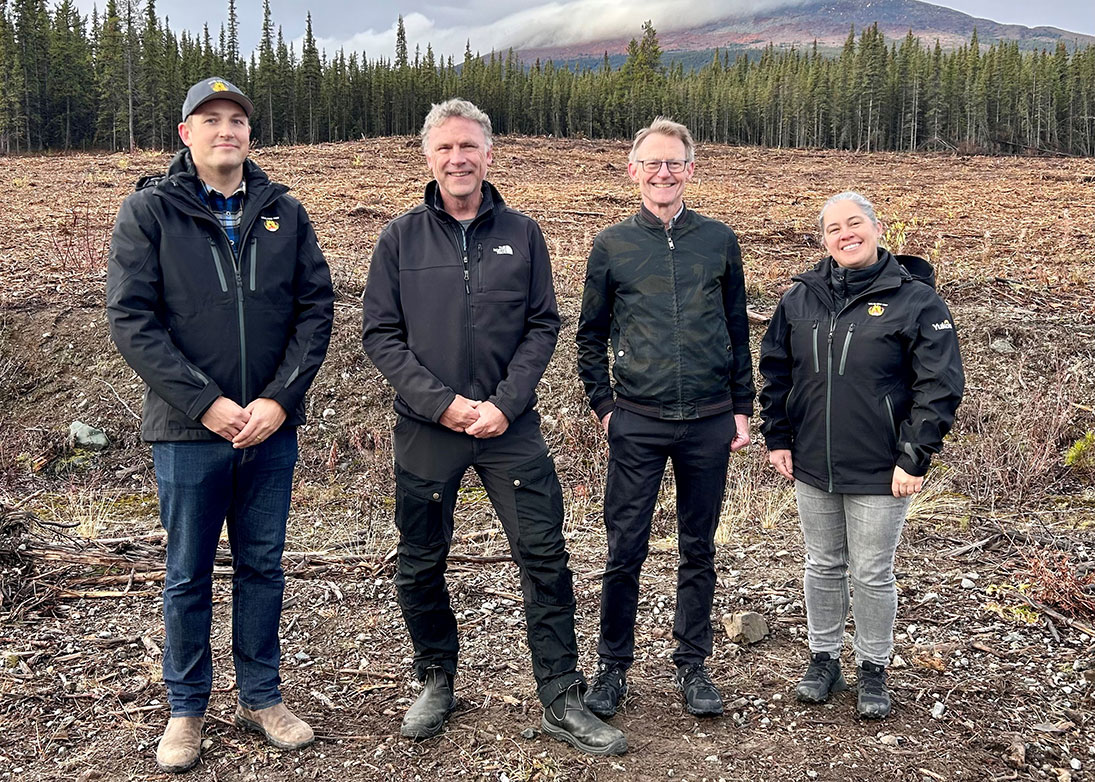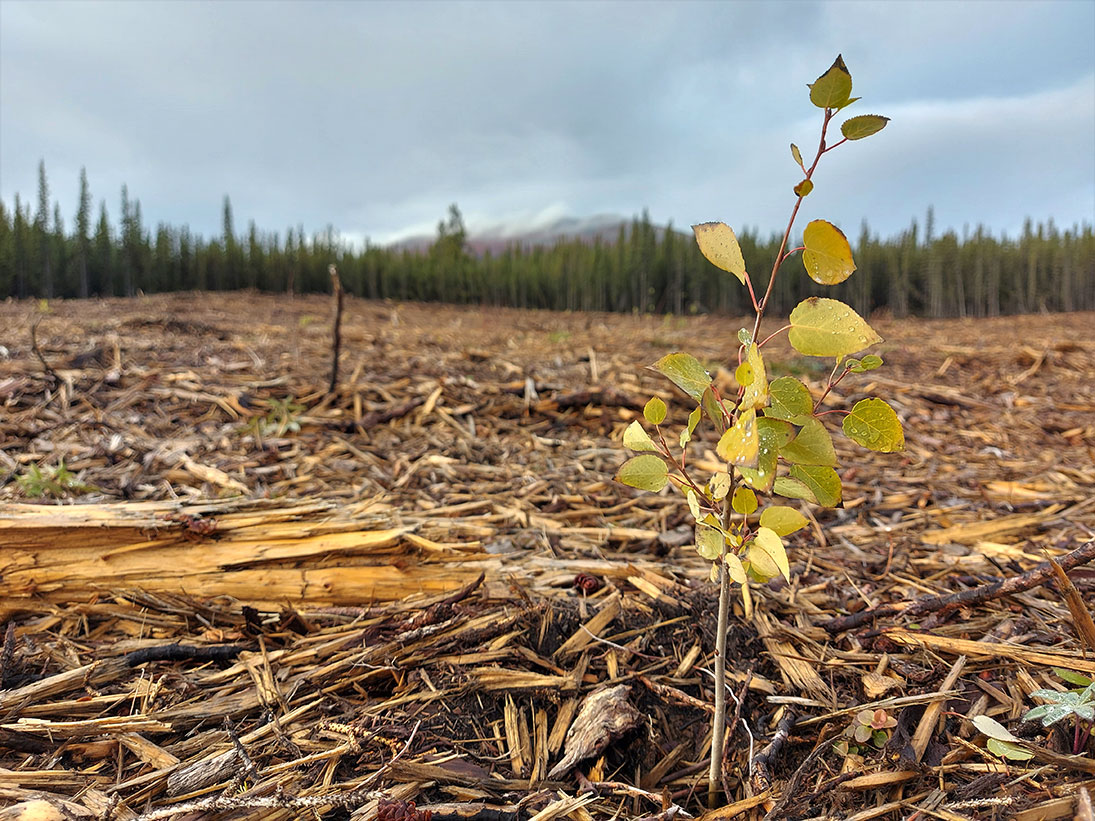400,000 fire-resistant trees to take root
The Yukon and federal governments are putting up a combined $1.1 million to plant 400,000 fire-resistant deciduous trees southwest of Whitehorse.
By Mark Page on October 16, 2023
The Yukon and federal governments are putting up a combined $1.1 million to plant 400,000 fire-resistant deciduous trees southwest of Whitehorse.
Fire behaviour experts believe this is the most likely direction a wildfire would threaten the city from, so they are trying to create zones where firefighters could safely and effectively make their stand.
The money is coming from a program called 2 Billion Trees that aims to plant trees on public land throughout Canada to reduce fire risk and create more green spaces.
Yukon Wildland Fire Management planted 90,000 aspen seedlings near Whitehorse and Haines Junction this past summer as part of the program.
On Friday, Yukon MP Brendan Hanley, Community Services Minister Richard Mostyn and Yukon Wildland Fire Management Director Lisa Walker gathered in one of the recently planted areas near Mt. Sima to announce the funding.
The areas were already cleared of quick-burning trees such as spruce and pine.
“In fuel breaks around Yukon communities, we are thinning and removing coniferous trees, which burn easily,” Mostyn said in a written statement.
“We can then re-plant the cleared areas with aspen seedlings.”
These leafy green trees better survive fires and can slow their spread.
“Aspen is a fire-resistant species, so planting aspen creates a forest more resistant to wildfire,” Mostyn’s statement reads.
This mimics the natural boreal forests of the Yukon.
The Yukon’s forests have a natural fire regimen, with burning and regrowing being normal. It actually helps prevent large-scale catastrophic fires.
Luc Bibeau, a fire mitigation expert at Yukon Wildland Fire Management, told the Star over the summer that the area between Whitehorse and Carcross have had years of fire suppression, altering this balance.
This has created a more flammable forest right in the area where prevailing winds blow straight toward Whitehorse.
Bibeau contrasted this with the more natural forest to the north and west of Whitehorse toward Dawson City.
“If you look at the boreal forest from the 30,000-foot view, you will see this patchwork mosaic,” Bibeau said. “I think it kinda looks like a quilt often if it’s healthy.”
In August, Mike Fancie, a Yukon government fire information officer, gave the Star a tour of the area southwest of Whitehorse where the aspen trees are now being planted.
At the time, Wildland Fire personnel were intentionally setting fires on the area to reduce flammable “fine fuels” such as sticks and other debris.
The end goal is not to totally stop a fire, but to give firefighters a place to work that is safe and where they can more easily build a fire break should the area be threatened.
“This fuel break is a 395-hectare guardian along the southern edge of Whitehorse,” Mostyn said at the announcement.
“In the event of a fire, these cleared areas would be a vital staging ground from which our crews would fight a wildfire.”
The zone is now being called the Whitehorse South Fuel Break.
Mostyn called this “critical infrastructure” to face a future with climate change causing larger and more severe wildfires.
Hanley focused on the fire resistance and other long-term benefits.
“Not only will these deciduous trees act as a natural defence against wildfires, they will also enhance biodiversity, restore habitat and increase carbon sequestration in our territory,” he said in a written statement accompanying the announcement.
In his remarks at the announcement, Hanley said this is part of “nature-based” solutions to climate change, comparing it to other government initiatives such as the banning of single-use plastics and clean fuel regulations.
The federal government will be providing $750,000 for the initiative, while the Yukon government foots the rest of the bill and oversees implementation and the actual planting of the trees.
Jonathan Wilkinson, the federal minister of Energy and Natural Resources said trees are “essential to our lives — they capture carbon, improve air
quality and support wildlife — and they are important allies in our fight against climate change.
“That’s why Canada has committed to planting two billion trees. We are pleased to be working with the Government of Yukon to collaborate by planting around 400,000 trees on public lands.
“This investment will expand forest cover, enhance resilience to wildfires and advance biodiversity restoration.”


Comments (9)
Up 1 Down 0
Sylvia Burkhard on Oct 22, 2023 at 7:58 am
If you can’t dazzle them with brilliance, baffle them with BS! Fire resistant trees haha, it’s called a green belt for a reason, why don’t we just use the common sense of our elders. The only trees that need culling are the evergreens and deadfalls. A true green belt with a decently wide firebreak is all we need. Oh yea, and folks who actually watch the fire activity and plan for the obvious and the unexpected. What I’ve also noticed is the lack of bombers parked ready to hit a fire before it takes off. Now it’s a wait and see then evacuate approach. Like everything government related these days, common sense has left the building. ps, Dawson’s firebreak on it’s only vulnerable side has completely grown in with spruce trees, would have been easy to keep it a viable firebreak. We simply cannot afford to put up with this lack of foresight, money and forest wise.
Up 2 Down 0
Nathan Living on Oct 20, 2023 at 2:29 pm
None if this would have happened if the City had not highlighted our vulnerability to wildfires.
Thank you for following in the cities footsteps.
Up 36 Down 5
Stephen on Oct 18, 2023 at 6:58 pm
I had a water resistant watch once and went swimming…the rest is history.
Up 37 Down 4
Karl on Oct 18, 2023 at 3:43 pm
Aren't these the kind of trees that grow up in an open space after a fire by themselves anyway?
Up 49 Down 16
Groucho d'North on Oct 17, 2023 at 9:06 am
Looks like our Prime Misery found a way to save face and honor a promise he made to Greta to plant two billion trees: But thousands of trees need to be cut down and burned before we can plant the new ones. A good case study on Progressive government: the more progressive they get - the behinder the public becomes.
Up 32 Down 10
AdmiralA$$ on Oct 17, 2023 at 7:45 am
A million freshly printed dollars on trees in the Yukon? While business is shuttering and prices are skyrocketed. Wow, keep pushing them prices up with big smiles, Spending ourselves out of debt. Anyone going to admit the top down keynes approach is not ever Going to work? Probably not look at the power it gives them all.
Up 52 Down 10
Cutforest Planttrees on Oct 16, 2023 at 7:33 pm
I believe the contract to have the natural forest cut down was +/- $4 million, and I have watched the contractor burn all the brush and undersized, green, carbon absorbing trees. "Fire resistant trees"... I have a bridge to sell the experts that settled on this phrase. So in a progressive environmentally conscious political setting, clearing a forest to plant trees is the answer. Forgive me for asking, what problem was solved here?
Up 47 Down 5
Forest for the trees on Oct 16, 2023 at 5:52 pm
What about the deadfall that hasn’t been cleared and the trees that have not been thinned in the city proper in decades(if ever)?
Up 48 Down 13
Matthew on Oct 16, 2023 at 4:26 pm
LOL! "Fire resistant trees"...